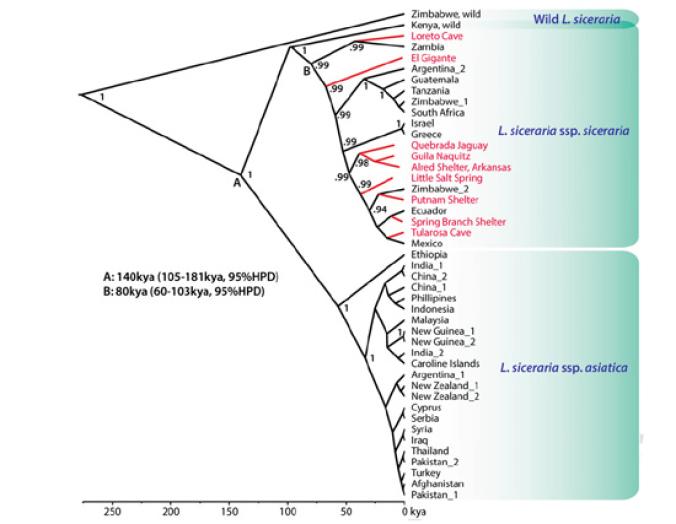
Many plants have worked their way into our lives, but few have done so with as much flair as the calabash. For over ten thousand years, people have used the calabash (known also as the bottle gourd and formally as Lagenaria siceraria) in all sorts of ways. They’ve eaten it as food. They’ve used it as fishing floats, as pontoons for river rafts, as goblets, as pipe stems. And around the world, people make music with it.
Here’s a whirlwind calabash concert tour around the planet:
Ravi Shankar jams on his sitar, the Indian classical guitar carved from a calabash, at the 1967 Monterey Pop festival:
Naná Vasconcelos plays the berimbau, the Brazilian instrument with a calabash as a resonator, in Rome in 1983:
From Mali, Toumani Diabate plays the kora:
And in China, here’s Crescent Dai performing (and talking about) the hulusi, also known as the bottle gourd flute:
The calabash is a domesticated plant that depends on us for its survival, like wheat or almonds. Its closest wild relatives grow in Africa. When people domesticated the gourd, they bred a rugged, light-weight shell that could hold up for years. But the course that the calabash took from wild plant to domesticated tool has been hard to uncover.
Archaeologists have found pieces of calabash dating back 11,000 in East Asia. In the New World, people were using calabashes at least 10,000 years ago.
In 2005, a team of scientists isolated some DNA from ancient calabashes in North and South America and found that they resembled calabashes from Asia more than African ones. Since the people of the New World originally came from Asia, traveling over the Bering land bridge, the scientists proposed that they took calabashes with them.
There’s a problem with this idea, though. If Asians carried calabashes into Alaska, they had to grow them along the way. But the short growing season in the Arctic would have made it impossible to rear the tropical plant. What’s more, the people who have settled in Siberia and Alaska don’t use any plants as containers. They use materials from animals, such as hides.
It was possible that the 2005 study didn’t have the precision to get the true picture of calabash history. The scientists only looked at a few genetic markers–tiny stretches of DNA at certain locations in the genes of different plants. It was possible that these markers had changed too rapidly over thousands of years, so that distantly related calabashes evolved similar sequences.
A group of researchers led by Logan Kistler at Pennsylvania State University decided to take another crack at the calabash. They gathered much more data this time around, gathering living gourds from every continent as well as the Pacific islands, and analyzing nine sets of ancient remains. And instead of looking for a handful of genetic markers, they sequenced 86,000 base pairs from the DNA in the chloroplast, the light-generating structures passed down from female plants to their offspring. By comparing the DNA from the plants, they were able to trace the branches of their family tree.
This is the tree. The x-axis is a time scale, going from 250,000 years ago to today. The numbers at the nodes are statistical measurements of how likely the trees are to be accurate. Branches with a 1 have the highest possible statistical support. The red names refer to gourds from archaeological sites in the New World.

As you can see, a wild African gourd belongs to the deepest branch. The tree then splits into two main lineages: one that includes African domesticated gourds, and the other that includes Asian ones. Both the ancient calabashes and the living ones from the New World belong to the African branch of the tree. If the calabashes had taken an Arctic journey, you’d expect a very different tree, with New World plants showing a kinship with Asian ones. This tree makes that journey hard to accept.
Making matters even worse is the great age of the New World lineages. Kistler and his colleagues tallied up the mutations along each branch to estimate how long ago they split from a common ancestor. The New World calabashes share a common ancestor with African calabashes 60,000 to 103,000 years ago. That’s long before people made their way to the New World about 15,000 years ago. However the calabashes originally got to the New World, it wasn’t on anyone’s shoulders.
Kistler and his colleagues argue instead for a different journey–or, rather, different journeys for people and plants. Back about 80,000 years ago, wild calabashes grew only in Africa. Sometimes their seeds were washed out to sea. Computer models of the Atlantic currents indicate that it might have taken just a few months for the wild calabash seeds to travel to the New World. The ocean-faring seeds sprouted in their new home. While Alaska would have been a poor place for the gourds to grow, places like Florida, Mexico, and Brazil would have been ideal.
Africa was likely the first place where people domesticated gourds. Different groups of people may have come across different wild populations of the plants, and selecting the gourds with the toughest shells to use as containers. When this happened is hard to say–the oldest archaeological evidence for gourds in Africa is less than 5,000 years old, but there could be other calabash fragments waiting to be discovered.
It’s tantalizing to look at the asiatica branch of the calabash tree. All the Asian, European, and Pacific gourds share a common ancestor with a domesticated Ethiopian gourd that lived 60,000 years ago. That’s right around the time that modern humans expanded from East Africa into the rest of the Old World. We know that by then they were using ostrich eggs as containers. They didn’t take ostriches with them out of Africa. Did they also take calabashes? That’s possible, but it’s also possible that a wild relative of the Ethiopian calabash spread across the water to coastlines in the Near East or South Asia, where people started to domesticate them.
What is clear is that people carried calabashes a long way, putting them in their canoes as they sailed to the islands of the Pacific. But there’s no evidence that the people who traveled across the Bering Land bridge had calabashes with them. Instead, the evidence suggests, their descendants eventually stumbled across wild calabashes growing along the east coast of North and South America, descendants of seeds that had drifted across the Atlantic while the ancestors of the people of the New World were living in Africa over 40,000 years before. And just as people in other parts of the world had done when they discovered wild calabashes, the people of the New World started using these plants.
Wild calabashes are practically impossible to find any more, either in the New World or in Africa. Humans may be the reason why. Originally, the plants probably developed big gourds to protect their seeds from small predators like birds and rodents. Only big mammals like ground sloths may have been able to feed on them. Like a number of other plants, calabashes may have had seeds adapted to survive a trip through the gut of a big mammal. The mammals could then spread their seeds in their droppings, maintaining the plants across a wide range.
Many of those giant beasts are now extinct. While the end of the Ice Age may have played a role in their demise, it’s also possible that human hunters may have helped push them towards oblivion. Having lost their animal partners, wild calabash would have started to dwindle. Meanwhile, though, humans were caring for a few strains of calabashes that had the traits they valued. Thus evolution pushed the calabashes to their remarkably durable state.
Scientists have long been impressed by the triumph of the calabash. Among domesticated species, only the dog has spread further. But the global journey of the calabash was actually two great trips, one taken by humans over land and another taken by plants, over the sea.